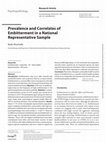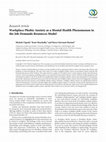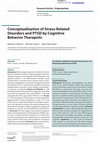Papers by Beate Muschalla
Psychosomatik Und Konsiliarpsychiatrie, May 1, 2008
Cogent psychology, Jun 20, 2023

Psychopathology, Sep 12, 2022
Introduction: Embitterment may occur after stressful but normal life events, such as job loss, di... more Introduction: Embitterment may occur after stressful but normal life events, such as job loss, divorce, or unjust events. Embitterment is a normal affect, but it may become clinically relevant in case it becomes very strong and long-lasting, and impairs daily functioning. Objective: Until now, no epidemiological data on the frequency of high embitterment in the general population have been available. Methods: A national representative survey of 2,531 people was carried out in Germany in 2019. The participants gave ratings for their embitterment due to perceived events (Posttraumatic Embitterment Scale), their psychological capacity profile (Mini-ICF-APP-S), sick leave duration, and sociodemographics. Results: About 11.7% of the investigated representative population report moderate embitterment, and another 3.8% high embitterment. Embitterment was only low correlated with other psychopathology, here work anxiety (r = 0.281**). There are no differences between embittered and nonembittered in respect to age, sex, household members, and professional distribution. Those with the highest embitterment have been unemployed more often and have lower income. At least 7.2% of those with high embitterment have a severe psychological capacity impairment and are in need of support by thirds to fulfill daily duties. In 55% of the 802 who reported a stressful event, injustice by an important person has been reported. Injustice by an institution (14%) or societal injustice (12%) was least often reported as a relevant stressful event. Conclusion: Physicians, therapists, and public health must be aware of embitterment as a specific mental health problem which occurs frequently and may become chronic with work and life participation problems.
Background: Psychotherapy has not only positive but also negative effects, which is especially tr... more Background: Psychotherapy has not only positive but also negative effects, which is especially true for group psychotherapy because of psychodynamic and interactional processes. Method: 71 patients who participated in cognitive behavioral group psychotherapy were reported unwanted events in the context of the group therapy. The answers were then validated in a qualitative interview. Results: 98,6 % of the patients reported some burden and 43,7% severe or extremely severe negative experiences. Most prominent is the induction of hopelessness and demoralization by what patients see and hear from co-patients. Conclusion: Unwanted treatment emergent effects are regularly seen in group psychotherapy.
Arbeitsplätze besitzen ihrer Natur nach zahlreiche potentiell angstauslösende oder angstverstärke... more Arbeitsplätze besitzen ihrer Natur nach zahlreiche potentiell angstauslösende oder angstverstärkende Charakteristika. Manifestieren sich arbeitsbezogene Ängste, können Absentismus und Langzeitarbeitsunfähigkeit bis hin zur Erwerbsunfähigkeit die Folgen sein. Bei Rehabilitanden findet man in 30 – 60 % der Fälle arbeitsbezogene Ängste, die die berufliche Wiedereingliederung erschweren. Aber auch bei psychisch gesunden Erwerbstätigen wurde bei 5 % der Beschäftigten eine arbeitsangstbedingte Neigung zur Krankschreibung gefunden. In der zukünftigen Forschung sollte arbeitsbezogenen Ängsten nicht erst in der Rehabilitation, sondern bereits präventiv am Arbeitsplatz selbst Aufmerksamkeit geschenkt werden. Das Konzept bietet Ansatzpunkte für psychische Gefährdungsanalysen, sowie Arbeitsplatzgestaltung und -passung.

BioMed Research International, 2017
Purpose. Anxiety-related problems at work are a serious problem in the occupational context, as t... more Purpose. Anxiety-related problems at work are a serious problem in the occupational context, as they come along with sick leave and problems in work participation. The aim of this study is to analyse workplace phobic anxiety in nonclinical context using the Job Demands-Resources model. Methods. The study involved a sample of 739 workers from a retail company, mostly with permanent contracts. Structural equation modelling analyses were performed using AMOS software. Results. Both the health impairment and motivational variables in the JD-R model were significantly related to workplace phobic anxiety and subsequently to absenteeism, specifically, exhaustion mediated between perceived job demands and workplace phobic anxiety and work engagement mediated between perceived job resources and workplace phobic anxiety. Moreover, workplace phobic anxiety was significantly positively related to absenteeism. Conclusions. Results suggest that workplace phobic anxiety is a specific concept and an important issue in organizations for both workers' health and the organizational costs linked to absenteeism. Supervisors and occupational physicians should be aware of workplace phobic anxiety, especially when workers are on sick leave often or for long periods.
Journal of American College Health, Sep 20, 2022
Psychotherapy and Psychosomatics, 2022

Verhaltenstherapie, Mar 30, 2023
Background: Many people experience stressful life events like social conflicts, accidents, or phy... more Background: Many people experience stressful life events like social conflicts, accidents, or physical violence. Some develop post-traumatic stress disorders (PTSD) thereafter. A diagnostic problem is the differentiation between causal stressful events, occasional causes, pseudo-causes or retrospective reinterpretations. This study investigates how often the diagnosis PTSD is mentioned in outpatient behavioral therapy patients, and which causes, findings, and therapeutic measures are reported. Patients and Method: In 1,480 behavioral therapy case reports the assignment of the diagnosis PTSD was explored. Cases with PTSD (N = 106) were compared with other cases without PTSD (N = 95). Results: In 7.16% the diagnosis PTSD was given. In both groups 90% reported earlier stressful experiences. In only 17% of the PTSD cases an "extraordinary threat of catastrophic proportions" was reported. In a quarter, the trauma assumption was based only on therapist or patient suggestions. Dissociative symptoms or intrusion were described only in the PTSD cases. Discussion: The data suggest that (a) almost all patients report stressful experiences, (b) the diagnosis of PTSD is given only in a limited number of patients, (c) in PTSD cases, intrusion and dissociation are reported only in a minority of cases, and (d) in PTSD cases, the full spectrum of exposure techniques is mentioned. Conclusion: Stress-associated disorders need precise description and differentiation.
Frontiers in Psychology, Jan 25, 2023
Health Psychology and Behavioral Medicine, Oct 19, 2022

Verhaltenstherapie, Oct 1, 2019
Ungerechtigkeitserleben am Arbeitsplatz kann einhergehen mit verschiedenen physischen und psychis... more Ungerechtigkeitserleben am Arbeitsplatz kann einhergehen mit verschiedenen physischen und psychischen Befindensstörungen, wie z.B. Schlafproblemen, reduziertem allgemeinen Wohlbefinden, erhöhten Arbeitsunfähigkeitszeiten und schlechter Stimmung. Bisherige Untersuchungsansätze zu Ungerechtigkeit am Arbeitsplatz sind vor allem deskriptiv vorgegangen. Das heißt, sie berichten Zusammenhänge, können jedoch keine Kausalaussagen darüber machen, ob Ungerechtigkeit zu psychischen Beschwerden oder gar Erkrankungen führt oder ob (gegebenenfalls bestimmte) psychische Erkrankungen zu stärker ausgeprägtem Ungerechtigkeitserleben beitragen. Bislang wurden vor allem allgemeine Effekte populationsbezogen untersucht, z.B. wie stark psychisches Missbefinden in einer bestimmten Stichprobe (z.B. ÄrztInnen in Finnland) zusammenhängt mit der Wahrnehmung ungerechter Ressourcenverteilung am Arbeitsplatz. Es gibt jedoch aus klinischer Perspektive und mit Berücksichtigung der transaktionalen Stresstheorie (Lazarus) Grund zu der Annahme, dass individuelle Voraussetzungen eine wichtige Rolle dabei spielen. Grundannahmen, wie beispielsweise der Glaube an eine gerechte Welt oder die Idee, dass nur Leistung im Leben zählt, oder aber die Überzeugung, dass gutes Zusammenleben mit Mitmenschen nur bei absoluter Loyalität möglich ist, spielen eine wesentliche Rolle dabei, wie verschiedene Menschen ein und dieselbe Arbeitssituation erleben, und gegebenenfalls auch mit Ereignissen oder Ungerechtigkeit umgehen. Dieser Artikel bietet eine Übersicht über bisherige Forschungsergebnisse. Therapeutisch-praktische Implikationen werden diskutiert und Fragen für zukünftige Forschung aufgeworfen.

Psychopathology, 2019
Background: Physicians and therapists are also consulted to give judgments on working ability. Ab... more Background: Physicians and therapists are also consulted to give judgments on working ability. Ability to work cannot simply be derived from the patient’s symptom status but from the illness-related capacity impairments in relation to the work demands. A structured assessment of capacity impairments has been evaluated and applied internationally: the Mini-ICF-APP Social Functioning Scale. It is currently unclear whether a free-text clinical report (i.e., usual clinical practice: clinical exploration according to clinical standards, but without a standardized documentation form, instead a text is written) and a structured capacity assessment correspond to the overall work ability judgment, i.e., the decision whether a patient is “fit for work” or “unfit for work.” Objectives: This investigation assessed, for the first time, whether usual clinical judgment and the additional structured capacity rating support the work ability decision. Methods: A total of 100 medical reports from patients in a psychotherapy hospital were excerpted for psychopathological symptoms and capacity disorders using a checklist. Additionally, a structured assessment of capacity disorders was documented on the Mini-ICF-APP rating for all patients. Results: In the free-text clinical medical report, endurance, flexibility, and contacts to others were the things mainly reported as impaired. This was similar to the structured Mini-ICF-APP rating. However, other capacity impairments were also reported in the Mini-ICF-APP, i.e., adherence to rules and regulations, planning and structuring, assertiveness, and group integration. When the free-text clinical report and the structured Mini-ICF-APP rating were compared, there was a higher rate of stated impairments covering all capacity dimensions in the Mini-ICF-APP rating. Conclusions: The free-text report in the medical report shows the differences between patients who are fit for work and those who are not, and thus speak for the validity of work ability decisions. However, optimization is possible in terms of depth and differentiation of capacity impairment description by adhering to the standard set by the Mini-ICF-APP.











Uploads
Papers by Beate Muschalla